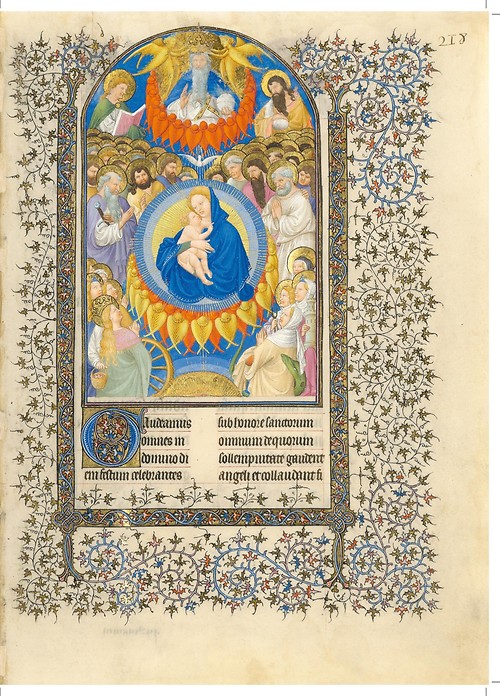Folio 218r
| « Previous Page | Next Page » |
Belles Heures of Jean de France, duc de Berry, 1405–1408/9. Herman, Paul, and Jean de Limbourg (Franco-Netherlandish, active in France by 1399–1416). French; Made in Paris. Ink, tempera, and gold leaf on vellum; 9 3/8 x 6 5/8 in. (23.8 x 16.8 cm). The Metropolitan Museum of Art, New York, The Cloisters Collection, 1954 (54.1.1).
Mass for All Saints
Heavenly Host, Folio 218r
This beautiful and formal devotional image gathers together all the heavenly realm: the Trinity; the Virgin and Child; cherubim and seraphim; and all the saints, many identified with their attributes. Catherine with her wheel is at lower left, Margaret with her dragon and Barbara with her tower at right. Stacked and repeated circles structure the composition.
Listen to a sample from the exhibition Audio Guide:
Audio clip: Adobe Flash Player (version 9 or above) is required to play this audio clip. Download the latest version here. You also need to have JavaScript enabled in your browser.
Audio Guide Transcript
Tom Campbell: For this illustration, the Limbourg brothers went for sheer opulence: a stunning vision of the Heavenly Hosts. It’s the beginning of the Mass of All Saints, celebrated on November 1. This is very much like an altar painting, in miniature. The composition is united by three circular arrangements down the vertical axis. At the top, God the Father is being crowned in gold by seraphim. He’s flanked by John the Baptist and John the Evangelist. In the middle, surrounded by golden rays and ranks of seraphim, is the Virgin Mary and the Child. Aside them are Saints Peter and Paul. And behind, a dense cluster of male saints, many visible by only their gold halos and a sliver of the tops of their heads. At the bottom center is part of a golden disk, with, on either side, clusters of female saints.
Reiterating the circular arrangement is the wheel next to Saint Catherine, a favorite saint of the duc de Berry. In all, this is not a page with the action, human insight, and visual wit of some of the “Picture Book” illuminations. Rather, it’s an image of monumentality on an intimate scale, and a lavish vision of the Heavenly Hosts.

